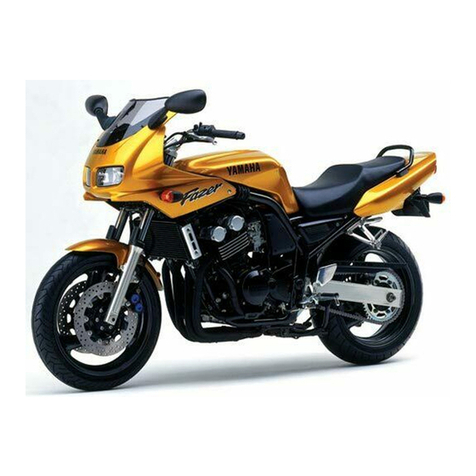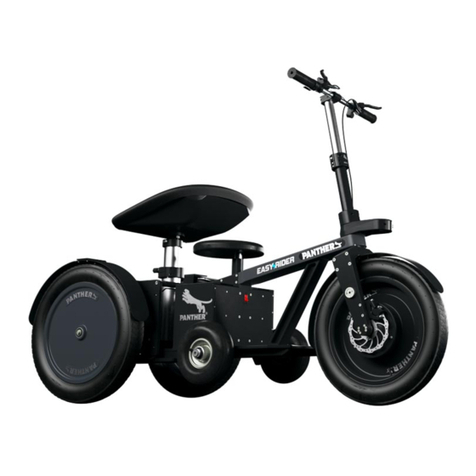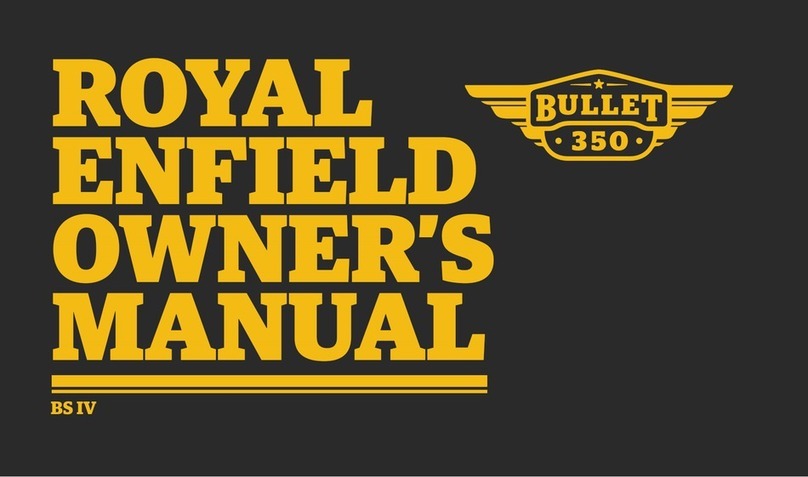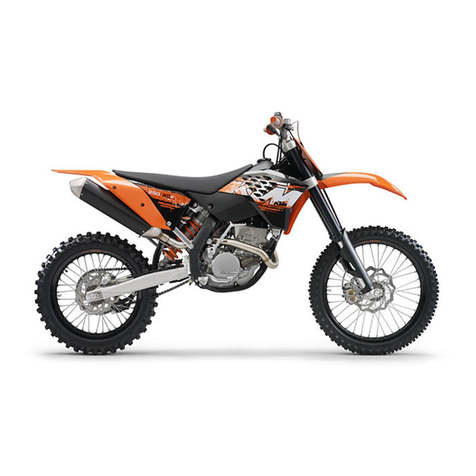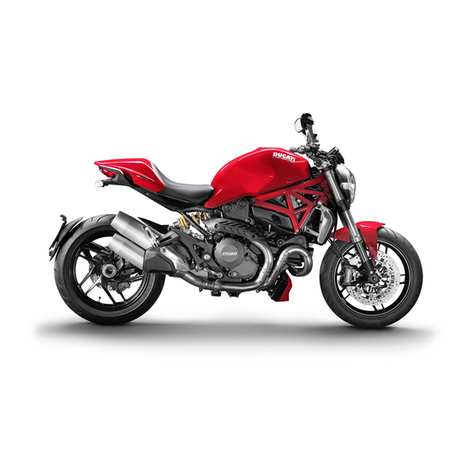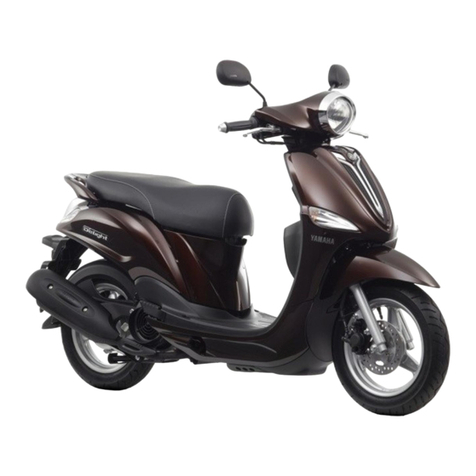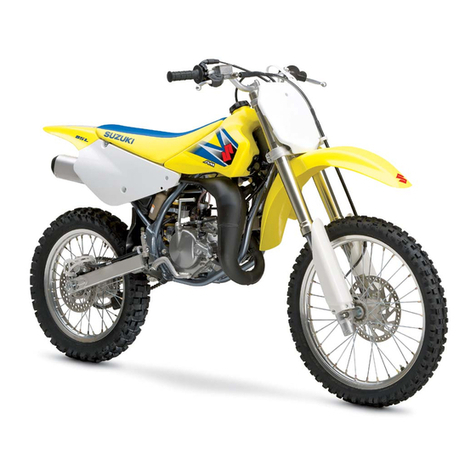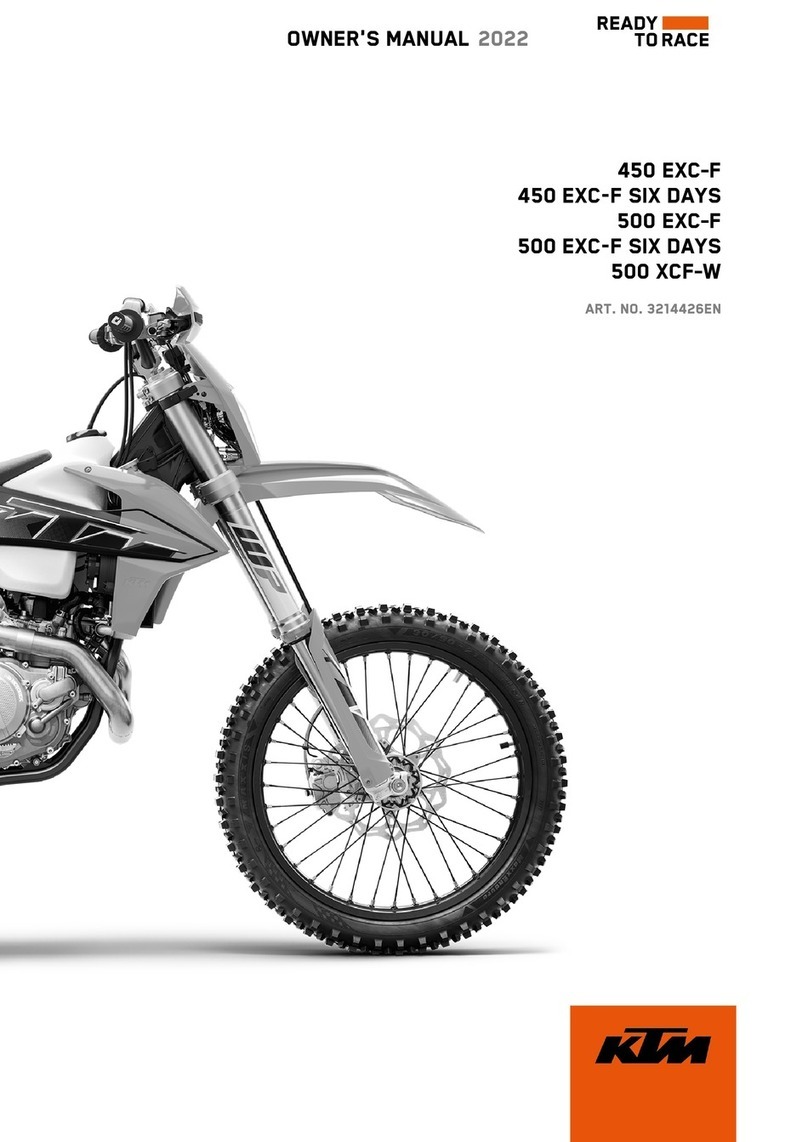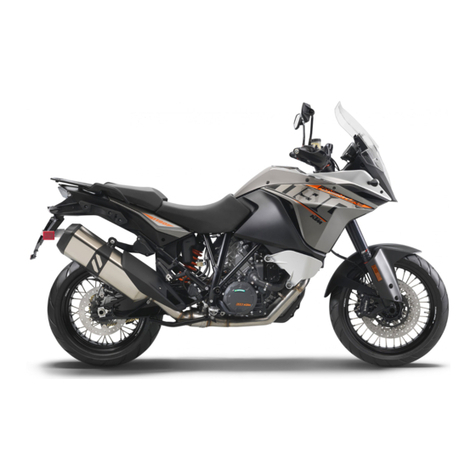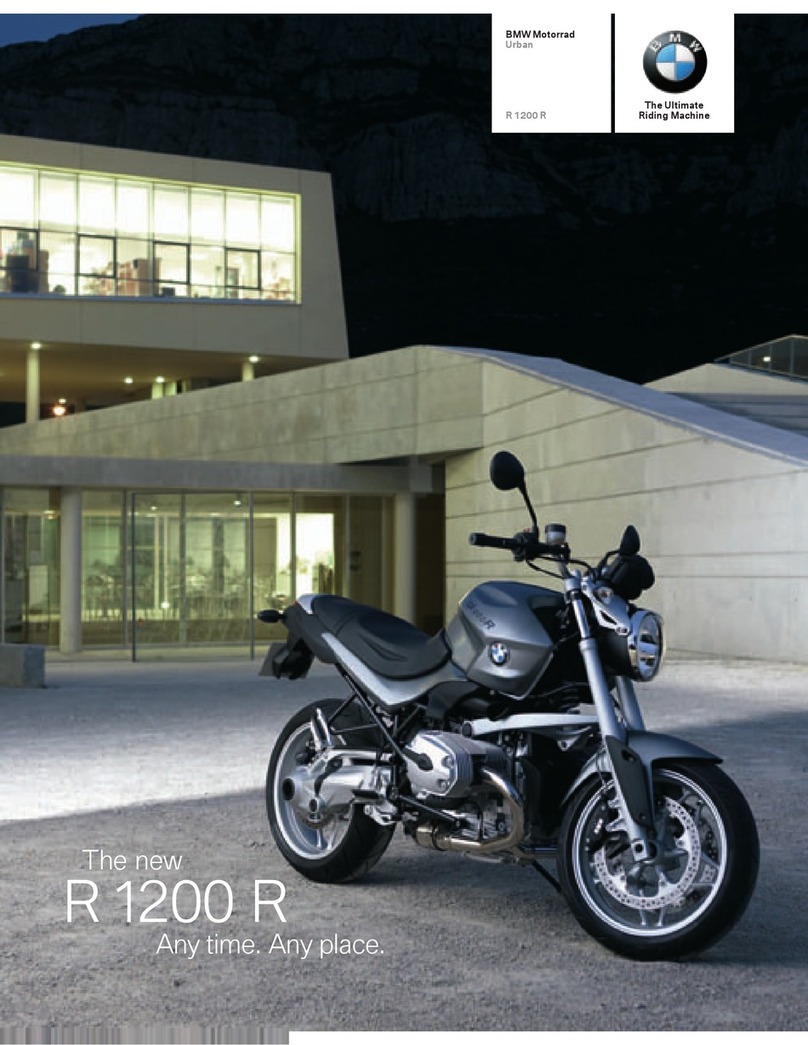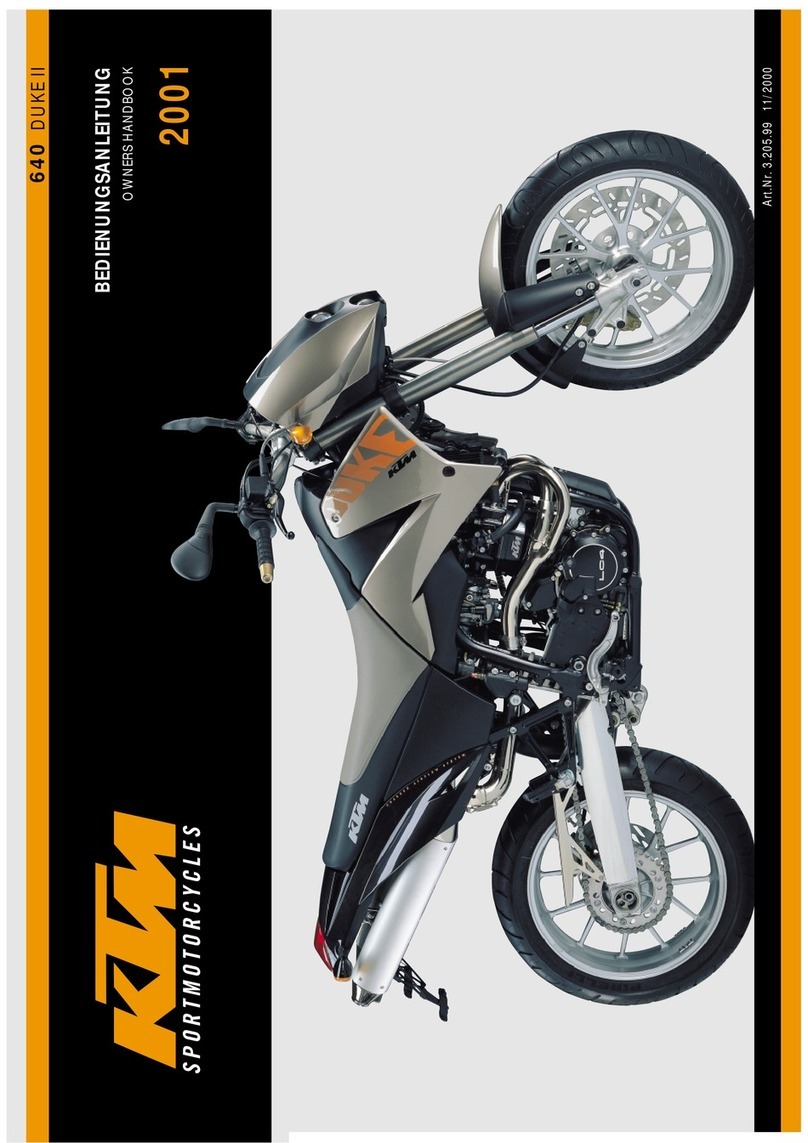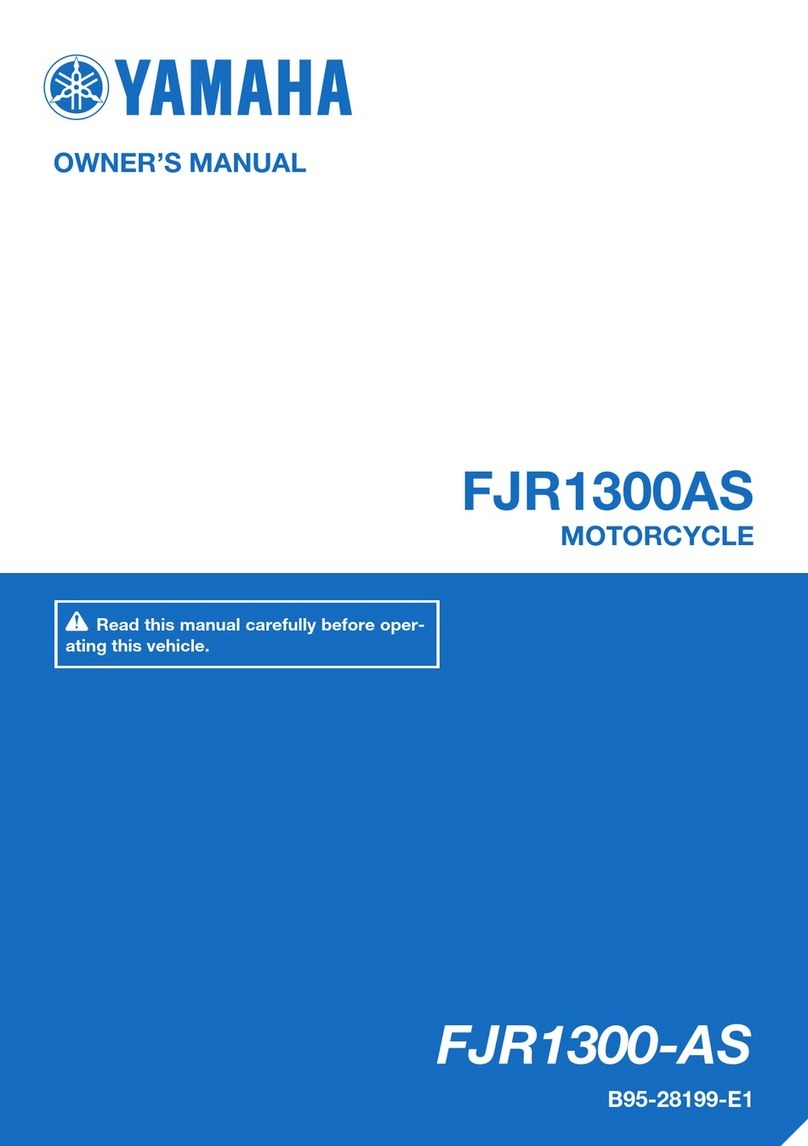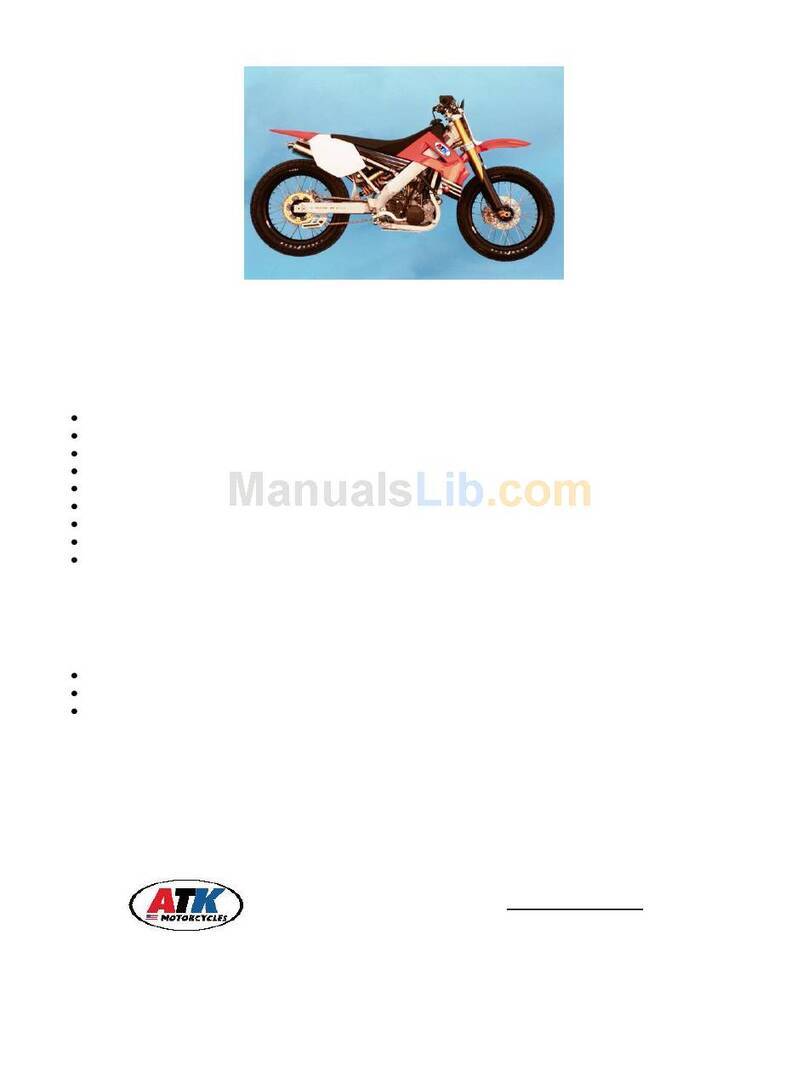MAEVING RM1 User guide


© Maeving Limited
This publication, or any part thereof, may not be reproduced, copied or
translated without the sole permission of Maeving.
Published: April 2022.
For the latest version of this handbook, please visit: www.maeving.com.
Produced by Illston Authoring Limited.
For more information visit www.illstonauthoring.co.uk.

3
CONTENTS
INTRODUCTION
Foreword ............................. 6
Contacts .............................. 6
Data protection statement .............. 6
General safety ......................... 7
Your Maeving RM1...................... 7
Symbols used in this handbook .......... 8
Labels on the motorcycle ............... 8
Parts identification ..................... 9
Owner information .................... 10
Serial number locations ............... 10
VIN number ....................... 10
Electric motor serial number........ 10
Battery serial number .............. 11
Key serial number ................. 11
QUICK START GUIDE
Turning the motorcycle on.............. 12
Confirm the battery has
sucient charge ...................... 12
Removing and installing the
primary battery ....................... 13
Charging the battery ................... 14
Checking the brakes ................... 14
Checking throttle operation ............. 15
Releasing the side stand ............... 15
Choosing a driving mode ............... 16
GENERAL INFORMATION
Instrument panel layout ............... 18
Warning lights ........................ 19
Traction battery indicator ........... 19
Malfunction indicator............... 19
12-volt battery indicator ............ 19
General warning indicator .......... 19
Information lights ..................... 20
Neutral indicator .................. 20
Headlight high beam indicator ...... 20
Direction indicators ................ 20
Instrument panel display ............... 20
Speedometer...................... 20
Traction battery charge percentage .. 20
Driving mode indicator ............. 20
Odometer ......................... 21
Trip computer ..................... 21
Clock ............................. 21
Ignition switch ........................ 22
OFF position ...................... 22
ON position ....................... 22
Steering lock ......................... 22
Engaging the steering lock . ......... 22
Disengaging the steering lock ....... 22
Ignition key ........................... 23
Adding new or replacement keys ....... 24
Immobiliser .......................... 24
Octo telematics device ................. 24

Maeving |RM1 Owner’s Handbook
4
CONTENTS
RIGHT-HAND HANDLEBAR CONTROLS
Drive mode buttons ................... 25
LEFT-HAND HANDLEBAR CONTROLS
Headlight dip switch ................... 26
Direction indicator switch .............. 26
Horn button .......................... 26
Information button .................... 26
Battery compartment unlock button .... 26
BATTERY
Single and twin battery usage .......... 27
Checking the battery is charged ........ 27
Caring for your battery ................ 28
Removing and installing the
primary battery ....................... 28
Accessing the primary battery ...... 28
Removing the primary battery ...... 29
Installing the primary battery ....... 30
Removing and installing the
secondary battery ..................... 31
Accessing the secondary battery .... 31
Removing the secondary battery .... 31
Installing the secondary battery ..... 32
Charging the battery ................... 32
Opening the battery storage
compartments if the
12-volt battery is flat .................. 34
SIDE STAND
Side stand ........................... 35
STORAGE COMPARTMENT
Storage compartment ................. 36
ELECTRICAL ACCESSORY SOCKET
Electrical accessory socket - USB ...... 37
SAFE OPERATION
Daily safety checks .................... 38
Battery ........................... 38
Wheels and tyres .................. 38
Nuts, bolts and fasteners ........... 38
Steering action .................... 38
Brakes............................ 38
Brake pads ........................ 38
Brake fluid levels .................. 38
Front forks ........................ 38
Rear shock absorbers .............. 39
Throttle ........................... 39
Electrical equipment ............... 39
Side stand ........................ 39
HOW TO RIDE THE MOTORCYCLE
Engaging drive and neutral ............. 40
Neutral button ..................... 40
Driving mode button ............... 40
Safety cut-out ........................ 40
Moving o ............................ 41
Braking .............................. 41
Parking your motorcycle ............... 42
ACCESSORIES AND LOADING
Accessories and loading ............... 43
MAINTENANCE AND ADJUSTMENT
Scheduled maintenance ............... 44
Throttle control ....................... 44
Braking system ....................... 45
Brake pad and brake disc
wear inspection ................... 46
Bedding in new brake pads and
brake discs ....................... 47
Brake pad wear compensation ...... 47
Brake fluid ........................ 47
Brake fluid level inspection
and adjustment ................... 48
Brake light switches ............... 49

5
CONTENTS
Steering and wheel bearings ........... 49
Steering inspection ................ 49
Inspecting the steering headstock
bearings for free play .............. 50
Wheel bearings inspection .......... 51
Suspension ........................... 51
Front suspension .................. 51
Front fork inspection ............... 52
Rear suspension................... 52
Rear shock absorber inspection ..... 52
Spring preload adjustment ......... 52
TYRES
Tyre inflation pressures ................ 53
Tyre wear ............................ 53
Tyre replacement ..................... 54
Rear wheel removal ................... 54
12-VOLT BATTERY
12-volt battery access panel ........... 59
12-volt battery removal and installation . 60
Battery disposal ...................... 61
Battery maintenance .................. 61
Battery discharge and storing
the motorcycle ........................ 61
12-volt battery charging ............... 62
FUSES
Accessing the fuse box ................ 64
Fuse identification ..................... 64
FRONT HEADLIGHT
Headlight adjustment .................. 65
CLEANING
Preparing to wash your motorcycle ..... 66
Seat care ............................. 67
Unpainted aluminium parts ............ 67
STORAGE
Storage .............................. 68
SPECIFICATIONS
Specifications ........................ 69
SERVICE AND MAINTENANCE
Servicing your motorcycle ............. 71
Arduous conditions .................... 71
Service history ........................ 72
General repair notes ................... 76
WARRANTY
Owner's responsibilities ............... 77
Maeving warranty terms and conditions .. 77
Introduction ....................... 77
Maeving warranty.................. 77
Maeving vehicle warranty........... 78
Maeving battery and drivetrain
warranty.......................... 78
Parts and accessories warranty ..... 79
Scheduled maintenance and
limited-service life ................. 79
Operational requirements........... 79
Exclusions ........................ 80
Incidental or consequential
damages ......................... 81
How do I obtain service under
this warranty? ..................... 81
Maeving approved partners ......... 81
Change of ownership .............. 82
Refunds and returns ............... 82

Maeving |RM1 Owner’s Handbook
6
INTRODUCTION
INTRODUCTION
Published: April 2022.
For the latest version of this handbook, please visit: www.maeving.com.
Foreword
Congratulations on the purchase of your Maeving RM1. You now
have the freedom to go where you want, when you want, with zero
emissions and maximum joy.
For the best experience, we recommend that you take the time to
read this handbook in its entirety before your first ride. It will provide
you with a better understanding of your motorcycle’s functionality,
operation, maintenance, and safety requirements. Please make sure
you fully understand the relevant warnings and familiarise yourself
with the controls to get the safest and best performance from your
motorcycle. It is important that you read and understand the Maeving
warranty. For further information, see Warranty on page 77.
In the interest of development, Maeving reserves the right to change
specification, design or equipment at any time.
This publication, or any part thereof, may not be reproduced, copied or
translated without the sole permission of Maeving.
The information contained within this handbook is correct at the
time of writing. It is designed to apply to all Maeving RM1 motorcycle
variants, therefore, the descriptions and images may vary slightly to
the model you have purchased. Future updates and amendments to
the handbook can be accessed via the website: www.maeving.com or
via the Maeving Support Team.
Charge on.
Contacts
For queries, to arrange a service or repair, or to register a change of
ownership, please contact us via the details below:
Telephone: +44 (0) 2477180149.
Opening hours: Monday - Friday | 9am to 5pm (GMT).
For general enquiries, please email the Maeving Support Team at:
For servicing and repairs, please email the Maeving Workshop at:
Please have the following information available when contacting us:
• Registered owner’s name and address (if you have not yet
gone through the proper transfer of ownership process,
please provide the details of the original owner). For further
information, see Change of ownership on page 82.
• Registered owner’s telephone number.
• Vehicle Identification Number (VIN), found on the chassis.
• Original date of purchase (if known).
• Motor serial number.
• Battery serial number (if the query is relating to the battery).
Data protection statement
Maeving Limited respects the privacy of each customer. For further
information, please visit: www.maeving.com.

7
INTRODUCTION
General safety
When riding your motorcycle, always wear the correct safety gear,
even for short journeys: an approved helmet, eye protection, riding
boots, gloves and protective clothing. Taking these precautions helps
to reduce the risk of injury in the event of an accident.
Make sure your motorcycle is maintained in good mechanical
condition by following the maintenance schedule and making any
recommended adjustments contained in this handbook. Be sure to
check your motorcycle before going for a ride. For further information,
see Daily safety checks on page 38.
Modifications to the motorcycle may render the vehicle unsafe, void
the warranty, and/or cause injury to yourself and other road users.
Therefore, Maeving cannot be held liable for any consequences as the
result of non-approved modifications.
It is not recommended to overload your motorcycle with large, bulky
or heavy items. This additional load may aect the handling of your
motorcycle and the eectiveness of the safety systems, as well as
void the warranty
Sometimes, motorists or pedestrians do not see motorcyclists
approaching, and electric motorcycles are virtually silent when in use.
Wearing bright or reflective clothing and maintaining a good road
position while riding can make you more visible to other road users
and provide you with extra room to take evasive action in the case of
an emergency.
Remember to signal when changing lanes or turning, and use the
horn to alert other road users of your presence where appropriate.
Never ride a motorcycle under the influence of drugs or alcohol, as
this is illegal and will impair your riding ability.
Operating a motorcycle on public roads without a licence is illegal
and could lead to prosecution. The formal training for correct riding
techniques, included in the licensing process, is essential for avoiding
loss of motorcycle control and accidents.
Your Maeving RM1
There are two versions of the Maeving RM1 available:
• L1e-B - The L1 variant has two driving modes available and is
speed-limited.
• L3e-A1 - The L3 variant has three driving modes available.
Maeving can derestrict an L1 variant motorcycle, in order to
increase the performance to that of the L3 variant. This needs to
be done by the Maeving Workshop Team or a Maeving Workshop
Partner and will come at an additional cost. To find out more, please
contact the Maeving Support Team. For further information, see
Contacts on page 6.
Variant Driving Mode
Maximum Speed
Km/h Mph
L1
145 28
232 20
L3
170 45
245 28
332 20

Maeving |RM1 Owner’s Handbook
8
INTRODUCTION
Symbols used in this handbook
Please familiarise yourself with the symbols contained within this
handbook. The symbols are provided for your safety and to avoid
harm when using your motorcycle or when connecting and/or
disconnecting parts.
Warning: A warning is to protect your personal safety. It
indicates a procedure that must be followed precisely, or
supplies you with information that should be given serious
consideration, in order to avoid the possibility of personal
injury or death.
Caution: A caution is to protect the safety and condition
of your motorcycle. It indicates a procedure that must be
followed precisely, or supplies you with information that
should be given serious consideration, in order to avoid the
possibility of damaging your motorcycle.
Note: A note gives general advice. It supplies additional
information, allowing you to experience the full benefits of
your motorcycle.
Labels on the motorcycle
For your own safety and for the safety of others, please pay attention to
the various labels on the motorcycle. It is impossible to warn you about
every hazard associated with operating and maintaining a motorcycle;
therefore, use your best judgement or contact the Maeving Support
Team for advice. For further information, see Contacts on page 6.
Do not remove or tamper with any warning labels fitted to any parts
of the motorcycle. The warning labels are fitted for your safety and to
prevent harm.
Tyre pressure label: The label is located on the
left-hand side of the swinging arm.
It identifies the recommended tyre size and
inflation pressures.
The statutory label: The label is located on
the left-hand side of the steering head on the
motorcycle frame. It identifies vehicle type, Vehicle
Identification Number (VIN), weight, power and
maximum speed.
This symbol is located on various parts of the motorcycle
to inform you and others that exposure to voltages can
result in shock and/or burns, and can even be fatal.
All Maeving motorcycles meet all vehicle recycling
requirements and End of Life Vehicle (ELV), Extended
Producer Responsibilities (EPR) and Waste Electrical
and Electronic Equipment (WEEE) recycling legislation.
Maeving will take back all batteries and dispose of them
in an environmentally responsible manner. For further
information, please visit: www.maeving.com.
The electrical components used on the motorcycle should only be
serviced by the Maeving Workshop Team or a Maeving Workshop
Partner. For further information, see Contacts on page 6.
Caution: Insulated electrical cables and wiring should never
be cut, tampered with, or modified in any way. The motorcycle
should not be used if the insulated cables appear damaged in
any way.
! ! !
! ! !
! ! !
! ! !

9
INTRODUCTION
Parts identification
1. Front brake lever and reservoir.
2. Rear brake lever and reservoir.
3. Instrument panel.
4. Secondary battery storage compartment.
5. Rear wheel motor.
6. Front indicator.
7. Front headlight.
8. Front fork.
9. Mirror.
10. Left-hand handlebar controls.
11. Right-hand handlebar controls.
12. Throttle control.
13. Front brake disc.
14. Front brake caliper.
15. Seat.
16. 12-volt battery access panel.
17. Side stand.
18. Reflector.
19. USB-C socket (in the storage compartment).
20. Rear light.
21. Rear indicator.
22. Foot peg.
23. Rear brake disc.
24. Rear brake caliper.
25. Rear shock absorber.
26. Primary battery compartment.
1 2
8
6
7
18
19
9
20
21
121110 15 18
22 23 24 25 26
14 16 1713
3 4 5

Maeving |RM1 Owner’s Handbook
10
INTRODUCTION
Owner information
When you take ownership of your RM1,
please enter your details in the
following boxes:
Name:
Licence plate:
Delivery date:
Name:
Licence plate:
Delivery date:
Name:
Licence plate:
Delivery date:
Serial number locations
Please locate and enter the serial numbers for your motorcycle.
VIN number
The Vehicle Identification Number (VIN)
is stamped onto the steering head of the
motorcycle frame, behind the headlight area.
Electric motor serial number
The electric motor serial number is
stamped onto the left-hand side of the rear
wheel, near the rear axle.

11
INTRODUCTION
Battery serial number
The battery serial number for each battery is
printed on the sticker on the battery.
Primary battery Secondary battery
Key serial number
The key serial number is stamped onto the
tag attached to the master key (red).

Maeving |RM1 Owner’s Handbook
12
QUICK START GUIDE
QUICK START GUIDE
Before every journey, please check the following to make sure that your motorcycle is ready to ride:
For further information, see Daily safety checks on page 38.
Turning the motorcycle on
The motorcycle must only be ridden using an ignition key (black) and
never using the master key (red).
For further information, see Ignition key on page 23.
Once the pre-ride checks have been completed satisfactorily and you
are ready to set o, insert the key into the ignition barrel and turn the
key clockwise to the ON position.
For further information, see Ignition switch on page 22.
Confirm the battery has sucient charge
Using the instrument panel, make sure that the charge indicator is
showing sucient charge for your journey.
For further information, see Checking the battery is charged
on page 27.
Note: Before the first ride on your motorcycle, make sure the
battery is fully charged.
! ! !
40
60
30
20
10
MPH
km/h
0
CHARGE %
80
40
20
50

13
QUICK START GUIDE
Removing and installing the
primary battery
If the battery needs to be charged before
your journey, it must be removed from the
motorcycle.
To remove the primary battery, turn
the ignition key to the OFF position. The
instrument panel displays OPEN and a 5
second countdown begins.
During the countdown period, press the
battery storage compartment unlock button,
located on the left-hand side handlebar
switch, once (one long press) to unlock
the battery storage compartment. Pull the
handle outward to open the compartment.
Using the carry handle, carefully remove
the battery from the battery storage
compartment.
To install the primary battery, open the
primary battery storage compartment, and
carefully lift the battery and lower it into
position.
Note: Make sure the ignition key is in
the OFF position before installing the
primary or secondary battery.
For further information, see Removing and
installing the primary battery on page 28.
Make sure the battery terminals locate into
the connector within the primary battery
storage compartment and close the battery
storage compartment.
Also make sure that the battery’s LED charge
indicator is facing the front wheel of the
motorcycle.
A secondary battery can be inserted into
the storage compartment which would
traditionally be the fuel tank.
For further information, see Removing
and installing the secondary battery on
page 31.
40
60
30
20
10
MPH
km/h
0
CHARGE %
80
40
20
50
! ! !

Maeving |RM1 Owner’s Handbook
14
QUICK START GUIDE
Charging the battery
To charge the battery, place the battery on the charging base (1),
making sure the terminals are connected to the battery securely, and
turn the power supply on.
The battery has an LED charge indicator (2). The charge indicator
displays the battery’s current State of Charge (SoC).
For further information, see Charging the battery on page 32.
Checking the brakes
Make sure the brakes are functioning correctly. To do this, squeeze
each brake lever independently to apply the front and rear brakes.
The levers should be firm and you will be unable to roll the
motorcycle forward or backwards with the brakes applied.
For further information, see Braking on page 41.
1
2

15
QUICK START GUIDE
Checking throttle operation
With the ignition key in the OFF position, open
the throttle and release it to confirm that it is
operating smoothly and that it returns to its
resting position correctly.
For further information, see Throttle control
on page 44.
Releasing the side stand
A safety cut-out sensor on the side stand
prohibits drive from being engaged while
the side stand is in the down position. The
side stand must be in the up position before
selecting 1, 2, or 3, using the driving mode
button (D), and riding o.
For further information, see Side stand on
page 35.

Maeving |RM1 Owner’s Handbook
16
QUICK START GUIDE
Choosing a driving mode
With the side stand in the up position, apply one of the brakes and
press the driving mode button (D) once to select driving mode 1.
Repeated presses of the mode button will select driving mode 2 and
then driving mode 3.
The instrument panel displays the current driving mode selection.
Note: The L3 version of the RM1 has three driving modes.
Driving mode 1 gives the best performance, but consumes
battery power more quickly and driving mode 3 is the most
economical.
Note: The L1 version of the RM1 has two driving modes.
Driving mode 1 gives the best performance, but consumes
battery power more quickly and driving mode 2 is the most
economical.
After selecting a driving mode, release the brake and gradually
turn the throttle towards you to apply power and accelerate the
motorcycle forward. Twisting the throttle away from you reduces or
eliminates (fully closed throttle) power. There are no gears to worry
about; just open the throttle and ride.
After your journey, stop the motorcycle, and with the brake applied,
press the Neutral (N) button. This will select neutral and prevent the
motorcycle from moving forward if the throttle is turned.
Note: If the motorcycle is stationary for 5 minutes and the
throttle or brakes are not operated in this time, neutral will be
automatically selected.
For further information, see Driving mode button on page 40.
! ! !
! ! !
! ! !

17
GENERAL INFORMATION
GENERAL INFORMATION
Vehicle range is defined as the distance that your motorcycle will
travel on a single full charge of the battery. This range may vary
due to many factors, including, the speed at which the motorcycle
is ridden, how hard you accelerate, the type of journey undertaken
(stopping and starting), the ambient temperature, use on inclines, and
the general service condition of your motorcycle.
As a direct reflection of your riding habits, it is advised to ride your
motorcycle conservatively, especially for first time use. You may
expect better range when ridden conservatively.
An electric vehicle’s energy consumption is averaged out over shorter
distances and it is designed to be recharged daily. Therefore, your
motorcycle may yield dierent ranges from one charge to the next.
The range may be increased by following the guidance notes
below:
• Type of commute: use on flat smooth roads, riding slower and
making fewer stops.
• Style of riding: maintaining a consistent speed, maintaining a
streamlined riding position to reduce drag and reducing the
weight of any cargo.
• Weather conditions: use during warmer, drier weather, riding
against less wind and on dry roads.
• Service condition: taking care of your motorcycle, making sure
the tyres are inflated to the correct pressure.
Using the driving modes 1, 2 or 3 will also aect the overall range
that your motorcycle can travel.
Note: The motorcycle is not designed for commercial
use. Incorrect use will invalidate the warranty, For further
information, see Maeving warranty terms and conditions on
page 77.
! ! !

Maeving |RM1 Owner’s Handbook
18
GENERAL INFORMATION
Instrument panel layout
1. 12-volt battery indicator.
2. Malfunction indicator.
3. Neutral indicator.
4. Direction indicator.
5. Headlight high beam indicator.
6. General warning indicator.
7. Speedometer.
8. Traction battery indicator.
9. Battery charge percentage.
10. Odometer, trip and time.
11. Driving mode indicator.
6
5
4
3
2
1
7
8
9
10
11

19
GENERAL INFORMATION
Warning lights
Traction battery indicator The amber traction battery indicator light illuminates if the battery’s State of Charge
(SoC) falls below 20%.
Malfunction indicator
The amber malfunction indicator light illuminates if there is a potential problem
with the motor or its control system. Please stop riding the motorcycle as soon as it
is safe to do so. Once your motorcycle is safely stored, please contact the Maeving
Support Team. For further information, see Contacts on page 6.
12-volt battery indicator
The red 12-volt battery indicator light illuminates if there is a potential problem with
the 12-volt system. The 12-volt battery is charged automatically by the main traction
battery whilst riding. If the indicator light remains illuminated before starting your
journey or illuminates whilst riding, please stop riding the motorcycle as soon as it
is safe to do so. Once your motorcycle is safely stored, please contact the Maeving
Support Team. For further information, see Contacts on page 6.
General warning indicator
The amber general warning indicator light illuminates if a fault is identified in one
of the control systems (immobiliser, battery control unit, instruments or motor
controller). The warning indicator is normally accompanied by an error code, which
is displayed on the instrument panel. Please stop riding the motorcycle as soon as
it is safe to do so. Once your motorcycle is safely stored, please contact the Maeving
Support Team. For further information, see Contacts on page 6.
Note: It is normal for the general warning light to turn on and be
accompanied by Error Code ‘001’ if the ignition switch is turned on without
the primary battery installed.
! ! !

Maeving |RM1 Owner’s Handbook
20
GENERAL INFORMATION
Information lights
Neutral indicator The green neutral indicator light identifies that the motorcycle is in neutral driving
mode, therefore, the motorcycle will not move forwards if the throttle is applied.
Headlight high beam
indicator
The blue high beam indicator light identifies that high beam has been selected. The
indicator light remains illuminated until the high beam is deselected.
Direction indicators
The green direction indicator light identifies activation of the indicators in conjunction
with operation of the direction indicator switch. The direction indicator arrow flashes
until the manoeuvre is cancelled.
Instrument panel display
Speedometer The speedometer displays the motorcycle’s current speed. The dial displays speed in
miles per hour (mph) and kilometres per hour (km/h).
Traction battery charge
percentage
The display identifies the current percentage of available traction battery charge as a
digital percentage.
Driving mode indicator The driving mode indicator light displays the currently selected driving mode. For
further information, see Engaging drive and neutral on page 40.
Table of contents


